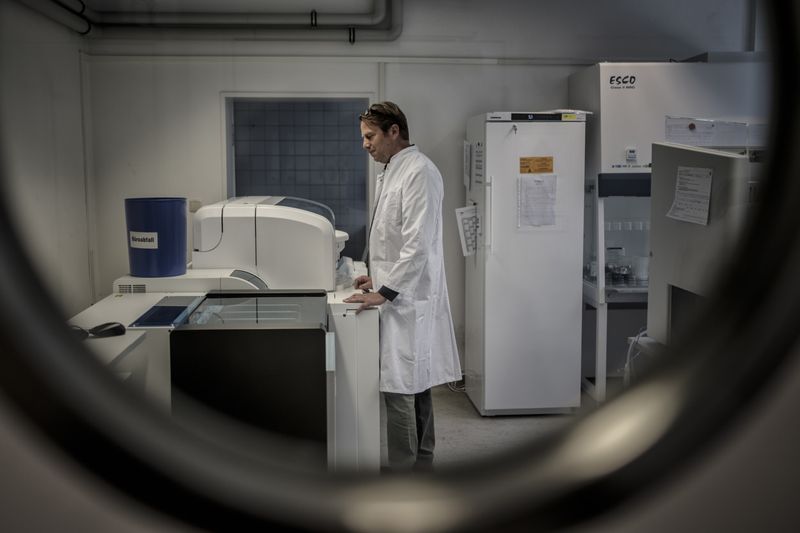
Munich: Dr. Camilla Rothe was about to leave for dinner when the government laboratory called with the surprising test result. Positive. It was January 27. She had just discovered Germany’s first case of the new coronavirus.
But the diagnosis made no sense. Her patient, a businessman from a nearby auto parts company, could have been infected by only one person: a colleague visiting from China. And that colleague should not have been contagious.
The visitor had seemed perfectly healthy during her stay in Germany. No coughing or sneezing, no signs of fatigue or fever during two days of long meetings. She told colleagues that she had started feeling ill after the flight back to China. Days later, she tested positive for the coronavirus.
Scientists at the time believed that only people with symptoms could spread the coronavirus.
“People who know much more about coronaviruses than I do were absolutely sure,” recalled Rothe, an infectious disease specialist at Munich University Hospital.
But if the experts were wrong — if the virus could spread from seemingly healthy carriers or people who had not yet developed symptoms — the ramifications were potentially catastrophic. Public awareness campaigns, airport screening and stay-home-if-you’re sick policies might not stop it. More aggressive measures might be required: ordering healthy people to wear masks, for instance, or restricting international travel.
Initial warning ignored
Rothe and her colleagues were among the first to warn the world. But even as evidence accumulated from other scientists, leading health officials expressed unwavering confidence that symptomless spreading was not important.
In the days and weeks to come, politicians, public health officials and rival academics disparaged or ignored the Munich team. Some actively worked to undermine the warnings at a crucial moment, as the disease was spreading unnoticed.
Interviews with doctors and public health officials in more than a dozen countries show that for two crucial months — and in the face of mounting genetic evidence — Western health officials and political leaders played down or denied the risk of symptomless spreading. Leading health agencies including the World Health Organisation and the European Centre for Disease Prevention and Control provided contradictory and sometimes misleading advice. A crucial public health discussion devolved into a semantic debate over what to call infected people without clear symptoms.
The two-month delay was a product of faulty scientific assumptions, academic rivalries and, perhaps most important, a reluctance to accept that containing the virus would take drastic measures. The resistance to emerging evidence was one part of the world’s sluggish response to the virus.
It is impossible to calculate the human toll of that delay, but models suggest that earlier, aggressive action might have saved tens of thousands of lives.
It is now widely accepted that seemingly healthy people can spread the virus, though uncertainty remains over how much they have contributed to the pandemic. Although estimates vary, models using data from Hong Kong, Singapore and China suggest that 30 per cent to 60 per cent of spreading occurs when people have no symptoms.
Unsolved riddle
Even now, with more than 9 million cases around the world and a death toll approaching 500,000, Covid-19 remains an unsolved riddle. But it is clear that an array of countries have fumbled their response, misjudged the virus and ignored their own emergency plans.
It is also painfully clear that time was a critical commodity in curbing the virus — and that too much of it was wasted.
On the night of Germany’s first positive test, Rothe tapped out an email to a few dozen doctors and public health officials.
“Infections can actually be transmitted during the incubation period,” she wrote.
Three more employees from the auto parts company, Webasto, tested positive the following day. Their symptoms were so mild that, normally, it’s likely that none would have been flagged for testing or would have thought to stay at home.
Rothe decided she had to sound the alarm. Her boss, Dr. Michael Hoelscher, dashed off an email to The New England Journal of Medicine. “We believe that this observation is of utmost importance,” he wrote.
Editors responded immediately. How soon could they see the paper? Dr. Michael Hoelscher, Director of the Department for Infectious Diseases & Tropical Medicine at Munich University Hospital in Germany, June 15, 2020. Dr. Camilla Rothe and Hoelscher’s team was among the first to warn about asymptomatic transmission.

The next morning, January 30, public health officials interviewed the Chinese businesswoman by phone. Hospitalised in Shanghai, she explained that she’d started feeling sick on the flight home. Looking back, maybe she’d had some mild aches or fatigue, but she had chalked them up to a long day of travel.
When the health officials described the call, Rothe and Hoelscher quickly finished and submitted their article. Rothe did not talk to the patient herself but said she relied on the health authority summary.
Within hours, it was online.
What the authors did not know, however, was that in a suburb 20 minutes away, another group of doctors had also been rushing to publish a report. Neither knew what the other was working on, a seemingly small academic rift that would have global implications.
Academic hairsplitting
The second group was made up of officials with the Bavarian health authority and Germany’s national health agency, known as the Robert Koch Institute. Their team, led by Bavarian epidemiologist Dr. Merle Bohmer, submitted an article to The Lancet, another premier medical journal. But the Munich hospital group had scooped them by three hours.
Bohmer said her team’s article, which went unpublished as a result, had reached similar conclusions but worded them slightly differently. Rothe had written that patients appeared to be contagious before the onset of symptoms. The government team had written that patients appeared to be contagious before the onset of symptoms — at a time when symptoms were so mild that people might not even recognise them.
After two lengthy phone calls with the woman, doctors at the Robert Koch Institute were convinced that she had simply failed to recognise her symptoms. They wrote to the editor of The New England Journal of Medicine, casting doubt on Rothe’s findings.
The journal did not publish the letter. But that would not be the end of it.
That weekend, Andreas Zapf, head of the Bavarian health authority, called Hoelscher of the Munich clinic. “Look, the people in Berlin are very angry about your publication,” Zapf said, according to Hoelscher.
He suggested changing the wording of Rothe’s report and replacing her name with those of members of the government task force, Hoelscher said. He refused.
The health agency would not discuss the phone call.
‘Flawed’ finding
Until then, Hoelscher said, their report had seemed straightforward. Now it was clear: “Politically, this was a major, major issue.”
On Monday, February 3, the journal Science published an article calling Rothe’s report “flawed.” Science reported that the Robert Koch Institute had written to the New England Journal to dispute her findings and correct an error.
The Robert Koch Institute declined repeated interview requests over several weeks and did not answer written questions.
Rothe’s report quickly became a symbol of rushed research. Scientists said she should have talked to the Chinese patient herself before publishing and that the omission had undermined her team’s work.
If Rothe’s paper had implied that governments might need to do more against Covid-19, the pushback from the Robert Koch Institute was an implicit defence of the conventional thinking.
Immediately after Rothe’s report, the WHO noted that patients might transmit the virus before showing symptoms. But the organisation also underscored a point that it continues to make: Patients with symptoms are the main drivers of the epidemic.
Once the Science paper was published, however, the organisation waded directly into the debate on Rothe’s work. On Tuesday, Feb. 4, Dr. Sylvie Briand, the agency’s chief of infectious disease preparedness, tweeted a link to the Science paper, calling Rothe’s report flawed.
With that tweet, the WHO focused on a semantic distinction that would cloud discussion for months: Was the patient asymptomatic, meaning she would never show symptoms? Or presymptomatic, meaning she became sick later? Or, even more confusing, oligo-symptomatic, meaning that she had symptoms so mild that she didn’t recognise them?
Bohmer, from the Bavarian health team, received a startling phone call in the second week of February.
Virologists had discovered a subtle genetic mutation in the infections of two patients from the Munich cluster. They had crossed paths for the briefest of moments, one passing a saltshaker to the other in the company cafeteria, when neither had symptoms. Their shared mutation made it clear that one had infected the other.
Bohmer had been sceptical of symptomless spreading. But now there was no doubt.
Now it was Bohmer who sounded the alarm. She said she promptly shared the finding, and its significance, with the WHO and the European Centre for Disease Prevention and Control.
Neither organisation included the discovery in its regular reports.
No consensus
The WHO still maintains that people who cough or sneeze are more contagious than people who don’t. But there is no scientific consensus on how significant this difference is or how it affects the spread of virus.
Public health officials saw danger in promoting the risk of silent spreaders. If quarantining sick people and tracing their contacts could not reliably contain the disease, governments might abandon those efforts altogether. Plus, preventing silent spreading required aggressive, widespread testing that was then impossible for most countries.
European health officials said they were reluctant to acknowledge silent spreading because the evidence was trickling in and the consequences of a false alarm would have been severe.
Looking back, health officials should have said that, yes, symptomless spreading was happening and they did not understand how prevalent it was, said Dr. Agoritsa Baka, a senior EU doctor. But doing that, she said, would have amounted to an implicit warning to countries: What you’re doing might not be enough.
By early March, while the WHO continued pressing the case that symptom-free transmission was rare, science was breaking in the other direction.
Researchers in Hong Kong estimated that 44 per cent of Covid-19 transmission occurred before symptoms began, an estimate that was in line with a British study that put that number as high as 50 per cent.
The Hong Kong study concluded that people became infectious about two days before their illness emerged, with a peak on their first day of symptoms. By the time patients felt the first headache or scratch in the throat, they might have been spreading the disease for days.
In Munich, Hoelscher has asked himself many times whether things would have been different if world leaders had taken the issue seriously earlier.
Still, the WHO is sending confusing signals. Earlier this month, Dr. Maria Van Kerkhove, the organisation’s technical lead on the coronavirus response, repeated that transmission from asymptomatic patients was “very rare.” After an outcry from doctors, the agency said there had been a misunderstanding.
“In all honesty, we don’t have a clear picture on this yet,” Van Kerkhove said.
Back in Munich, there is little doubt left. Bohmer, the Bavarian government doctor, published a study in The Lancet last month that relied on extensive interviews and genetic information to methodically track every case in the cluster.
In the months after Rothe swabbed her first patient, 16 infected people were identified and caught early. All survived. Aggressive testing and flawless contact tracing contained the spread.
Bohmer’s study found “substantial” transmission from people with no symptoms or exceptionally mild, non-specific symptoms.
Rothe and her colleagues got a footnote.








